The December trade release surprised some observers in terms of the rise in imports. [0] I think there are some other interesting implications. First, the implied downward revision in GDP is minimal. Second, the drop was less pronounced in the ex-oil trade balance. Third, although real trade flows are rising from their troughs, they have not re-attained pre-Lehman levels. Fourth, the US-China goods trade balance continues to improve.
Implications for Estimated GDP Growth
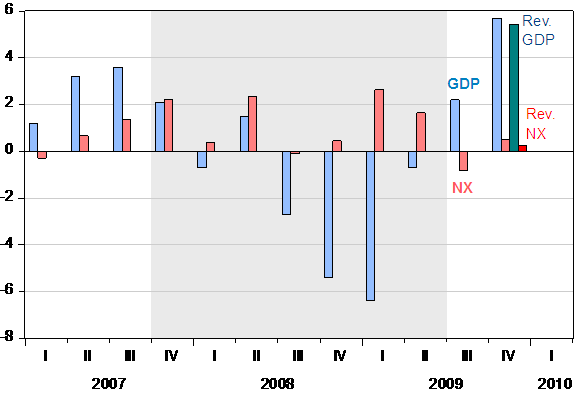
Figure 1: GDP growth rates, SAAR (light blue bar), net exports (NX) contribution (salmon bar), implied GDP growth rate (dark teal bar), implied net exports contribution (red bar). Implied growth rates and contribution use December 2009 trade release for real goods, assumes services trade balance is as assumed in 2009Q4 advance release. NBER recession dates shaded gray, assumes recession ends 09M06. Source: BEA, 2009Q4 advance GDP release, BEA/Census December trade release, NBER, and author’s calculations.
The implied reduction in GDP growth is on the order of 0.25 percentage points.
The Trade Surprise, and the Role of Oil
The ex-oil trade balance continues to decline, but at a much slower pace than the total trade balance.
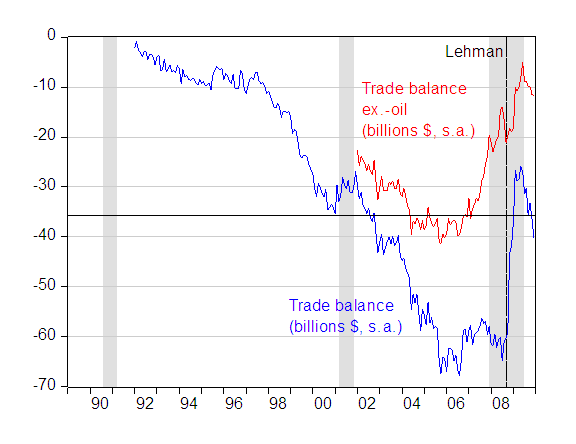
Figure 2: Trade balance (blue), and trade balance ex.-oil imports (red). NBER recession dates shaded gray, assumes last recession ends 09M06. Horizontal solid line is Bloomberg consensus. Source: BEA/Census, December trade release, NBER, and author’s calculations.
The sensitivity of the US trade balance to fluctuations in the oil price (see also CR Haver) reminds me that the imperative still remains to reduce America’s dependence on imported oil. That can be done in any number of ways; in my 2005 Council on Foreign Relations report on the twin deficits, I suggested a gasoline tax (see also [1] [2]). However, a price on carbon would also serve to reduce oil imports, and I think reducing oil imports is an important component in attaining a sustained reduction in the US current account deficit.
Real Trade Flows and the Goal of Doubling Exports
Real US trade flows are recovering, but have not yet “recovered”.
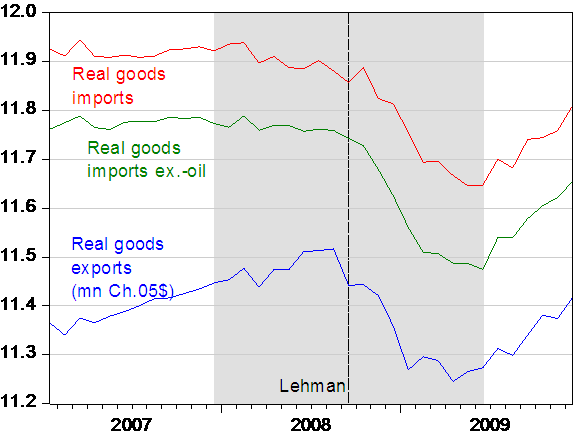
Figure 3: Log real goods exports, (blue), log real goods imports (red), and real goods imports ex.-oil (green), all in millions of Ch.2005$, seasonally adjusted. NBER recession dates shaded gray, assumes last recession ends 09M06. Source: BEA, December trade release, NBER, and author’s calculations.
One point has struck me; not only are exports below pre-Lehman levels, in some sense they have been below below what would be expected from a traditional trade flow equation (an ECM expressing exports as a function of rest-of-world income and the real exchange rate, estimated over 1973-00, suggests that exports have been running 10% under predicted, in log terms, over 2001-07).
This observation is relevant when thinking about the Administration’s goal of doubling exports (presumably nominal) by end-2014 (see the discussion of the goal this post). If there is reversion to (cointegrated) trend, then the objective becomes more plausible.
On this point, the Economic Report of the President, released on Thursday, notes (Ch. 4, p.133):
Exports can be expected to rise rapidly as the world economy recovers for a number of reasons. Just as trade typically falls faster than GDP in a recession (discussed in Chapter 3), it typically grows faster during a rebound. Trade-to-GDP ratios have fallen in the last year and can be expected to bounce back as the world economy recovers. This bounce-back alone will lead to rapid export growth. More generally, the crucial driver of exports is
always the performance of the world economy. For U.S. goods and services to be bought abroad, demand in other countries must return robustly. This is one reason for the United States to strengthen its ties with fast-growing regions such as emerging East Asia. The faster our trade partners grow and the more we trade with fast-growing economies, the more demand for U.S. exports grows….
The ERP also has a lot of interesting material covering new developments in international trade theory, including the roles of productivity, fixed entry costs and vertical specialization in trade (see Chapter 10). In particular, some attention is devoted to vertical specialization:
…Today, multinational corporations (U.S. or foreignbased)
are involved in 64 percent of U.S. goods trade (imports and exports),
and fully 19 percent of U.S. goods exports are sales from a U.S. multinational
firm to its affiliates abroad. An increase in international vertical specialization,
where firms have production in multiple countries and break up the
production of a particular good into stages across different countries, has
contributed significantly to growth in world trade. The process can be within
a large firm or intermediate inputs can be bought and sold on the market.
Decreased trade costs have made it easier to break up the value chain of
production as various parts of production can be done in different places
and an in-process good can be shipped many times before final assembly.
One study estimates that roughly one-third of the growth in world trade
from 1970 to 1990 was attributable to the growth in vertical-specialization
exports (Hummels, Ishii, and Yi 2001). Calculations about the extent of
vertical specialization vary from estimates that 30 percent of OECD exports
contain imported inputs to estimates that intermediate inputs account for
up to 60 percent of world trade.
As I noted in the post on doubling exports, to the extent that vertical specialization is an ever more pervasive phenomenon in US trade, then the growth in gross exports might become ever more rapid, and more rapid than value added in exports. However, in the absence of more precise and frequent measurement, this can only be a conjecture. (More on vertical specialization [4], [5].)
The US-China Trade Balance
Finally, on a non-economically interesting but politically sensitive variable, the US-China trade balance continues to improve, despite the stabilization in the US-China exchange rate.
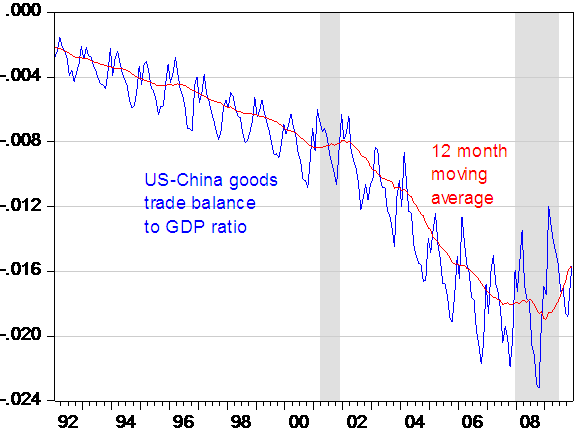
Figure 4: US-China goods trade balance (blue), and 12-month moving average of trade balance (red), both normalized by monthly nominal US GDP. NBER recession dates shaded gray, assumes last recession ends 09M06. Source: BEA/Census, December trade release, Macroeconomic Advisers February 12, 2010 release, NBER, and author’s calculations.
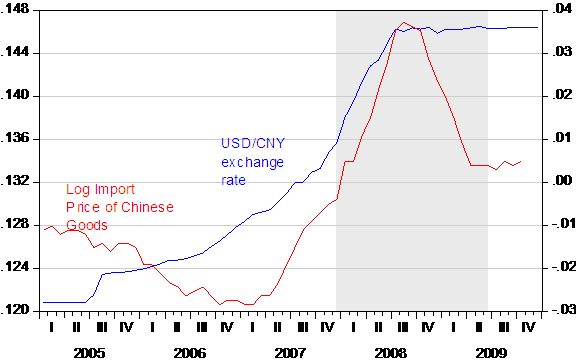
Figure 5: US dollar/Chinese yuan exchange rate (up is depreciation of USD) (blue, left axis), and log import price of Chinese goods, 2003=0 (red, right axis). NBER recession dates shaded gray, assumes last recession ends 09M06. Source: FRED II, and BLS, import/export price release.
If the conjecture of some analysts that a resumption of yuan appreciation is imminent [6], then continued reduction in the US-China trade deficit is more likely at least over the short term.
How exactly would a higher gasoline improve the overall trade balance? After all, the current account balance is the inverse of the capital account balance (aside from changes in reserves). How does a higher gasoline tax either raise savings or reduce investment? Indeed, if consumers reduced savings in response to higher taxes and the government spent the gas tax revenue, the net effect of a gasoline tax would be to make the current account balance worse, not better.
Beyond that why should oil imports (as distinct from any other import) adversely impact the current account? The oil producers tend to spend their revenues (with a lag). Stated differently, high oil imports should be matched by higher exports, not trade deficits.
Empirically, the linkage between oil imports and trade deficits doesnt make sense. Indeed, many of the countries with the largest per-capita oil imports have very large trade surpluses. Korea, Japan, and Germany come to mind.
Conversely, the countries with largest current account deficits are typically either bubble babies or have huge public sector deficits or both. The U.S., Spain, Ireland, the UK, etc. all come to mind. Oil does not appear to be a material factor.
The economy is dependent on oil. Reducing oil consumption, at this point, is quite likely to reduce economic activity as well–or at least inhibit its recovery. See my articles, “Oil: What Price can America Afford?” and “Peak Oil Economics” for more.
If you want to ease energy constraints and improve the trade balance, try substituting natural gas into traditional oil applications. See a bit on the economics of that here: http://www.aspousa.org/index.php/2010/02/the-market-potential-of-cng-as-a-transportation-fuel/
I would add, from a pedagogical point of view, that this latter-mentioned article applies some very solid, basic market and venture capital analytical tools. I believe that these are not taught in economics courses, but they’re still very helpful in thinking through policy or investment alternatives and should be in every policy analyst’s tool kit. The article may be worth a look on that basis, if no other.
As a by-the-way, I would note we’re conducting a workshop with Center for Energy, Marine Transportation and Public Policy at Columbia University in New York on the use of CNG in transportation. We don’t have a position on the topic one way of the other, but are curious to see how the analysis turns out, and we look to present on the topic in the second half of April in DC or NY, for those who may be interested.
At a minimum, I can say that the pre-conditions for migration of natural gas into traditional oil uses are present, and that we would expect to see such a migration, here or in other countries, in the next 5-7 years.
Steve,
What does CNG stand for? Coal to NG, maybe, as in coal gasification?
Just wondering because I was a Sasol stockholder for a number of years, and they do this in S. Africa, except take it one step further and transform coal gas to liquid fuel using the FischerTropsch process.
Problem here is their S. African plant is the single largest point source of CO2 in the entire world. Some projects started in the US, but this will be a problem.
CNG stands for Compressed Natural Gas. See the Wikipedia page on the subject.
Cedric wrote:
Problem here is their S. African plant is the single largest point source of CO2 in the entire world. Some projects started in the US, but this will be a problem.
Perhaps not a problem. S. Africa certainly has some lush plant life. Plants just love CO2.
Oh, how is this year’s global warming working out for you?
It amazes me that there are reasonable intelligent people who would still prefer pieces of paper, or cloth, or entries to a ledger to real goods and services. One thing that the supply side revolution proved in the 1980s (predicted by John Rutledge) is that when the currency is stable the world rushes to the dollar. That means imports exceed exports. When the balance of payments indicates more exports than imports it is actually an indicator of bad economic times.
Can you name one major company that does not import? Do you actually believe that it would be better for those companies not to import?
This is just more evidence of the weakness of GDP as a measure. It is based on long discredited and debunked mercantilist (Keynesian) theory.
RicardoZ,
We call it “climate change” now, just to cover all the bases. Whether we want to believe climatologists or not, we can believe governments are going to tax it until Hell freezes over.
Steve Kopits: Is the US economy more “dependent on oil” than small, rich, stable northern European countries? No and Yes. Yes, it is to the extent that US armed forces depend on oil for both aerial bombing campaigns and moving around boots on the ground. Deploying US armed forces against civilian populations is an integral part of the American “cheap energy” policy.
Do you think it is possible to wean Americans off killing children and grandparents? Following your Alchian Armen-type logic that observed institutions are 2nd-best constrained optimal, is not the security and integrity of the nation state of the USA dependent on killing large numbers of innocent civilians?
A schedule of excise tax increases on gasoline and diesel or new carbon taxes could be announced and implemented over a several year period. There need be no nasty surprise shock. It would be the first time that the USA ever credibly commits to energy conservation. I believe that global oil prices would fall to the point that in net, the average American citizen would be better off, i.e., wealthier per capita.
Expecting a major shift to natural gas in less than a decade is not realistic. Natural gas infrastructure is expensive. Heavily taxing oil would encourage that migration.
Incidentally, the US is the leader in the galloping obesity epidemic. Cheap energy and massive agricultural subsidies have likely contributed to this alarming situation. From a traditional Christian perspective, the self-inflicted damage reflects to what extent ordinary Americans have fallen from grace. It suggests moral and spiritual bankruptcy. In the material world, obesity and related COPD will slow worker productivity growth.
We have our dependence on foreign oil. We are fighting wars in Iraq & Afghanistan. We have military bases all over the world.
There’s no way our trade deficit will turn around.
“For U.S. goods and services to be bought abroad, demand in other countries must return robustly. This is one reason for the United States to strengthen its ties with fast-growing regions such as emerging East Asia. The faster our trade partners grow and the more we trade with fast-growing economies, the more demand for U.S. exports grows….”
And the more U.S. imports will grow, until agricultural exports give U.S. manufacturing a terminal case of “Dutch Disease.”
GNP,
The US uses energy because it is a great producer. How does the US production stand up to the rest of the world? The rest of the world does not even have the capacity to use as much energy as the US.
Then consider energy savings. The US has had an explosion in energy needs and yet the energy consumption has not risen significantly. If you look at the use of oil products a graph is virtually flat since 1990. How have we done this? We have the greatest energy conservation products in the world. While the rest of the world is using significant labor to produce one product we produce thousands with the same labor for only a small increase in energy use.
You are buying into the hype. Think deeper.